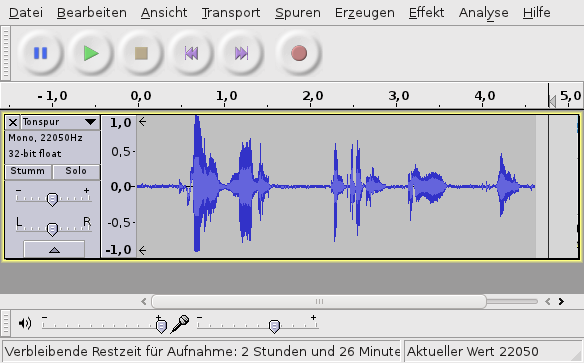Marble/VoiceOfMarble/Recording: Difference between revisions
< Marble | VoiceOfMarble
Earthwings (talk | contribs) (→Tipps) |
(→Tipps) |
||
| Line 17: | Line 17: | ||
# Export the voice sample (File, Export) as ogg vorbis. See the [[Marble/VoiceOfMarble/Translations|translations]] page for the filename | # Export the voice sample (File, Export) as ogg vorbis. See the [[Marble/VoiceOfMarble/Translations|translations]] page for the filename | ||
== | == Tips == | ||
* Make sure no other sound disturbs your recordings. | * Make sure no other sound disturbs your recordings. | ||
* Repeat several recordings to find the optimal volume setting of the microphone | * Repeat several recordings to find the optimal volume setting of the microphone | ||
Revision as of 02:06, 16 June 2011
Audacity is an open source audio recorder. It's a good choice to do your voice recordings for Marble. Of course it's also possible to use different software if you want to.
Initial Setup
- Ask your system administrator to install audacity on your system if it's not installed yet. Audacity is available in any sane Linux distribution. Versions for Mac and Windows exist as well.
- Connect your microphone to your system
- Start audacity
Voice Sample Recording
- Get another voice sample to speak from the translations page
- Press the record button in audacity
- Speak the text
- Press the stop button
- Play the spoken text. If it's not ok, record it again
- Cut any excessive silence at the start and the end
- Normalize the voice sample (effects menu)
- Export the voice sample (File, Export) as ogg vorbis. See the translations page for the filename
Tips
- Make sure no other sound disturbs your recordings.
- Repeat several recordings to find the optimal volume setting of the microphone
- Sometimes it's easier to speak longer sentences or to repeat the same text several times and to cut the recordings afterwards
- Don't record everything in one go, but make smaller breaks between. Try to avoid longer breaks though (e.g. lunch).
- Don't rush. Quality recordings take their time

